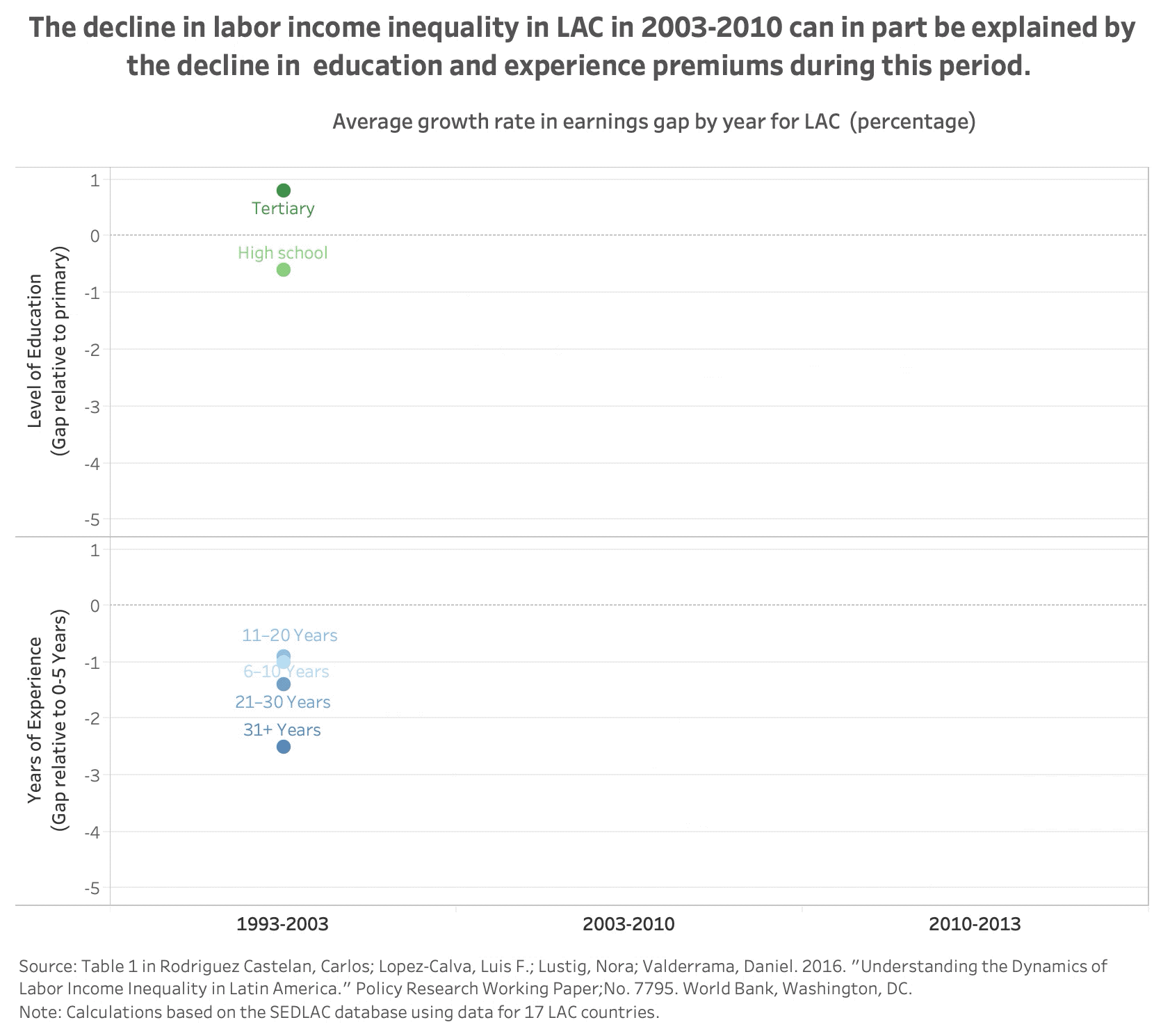Learning more, earning less: The role of falling returns to education and experience in “reducing” inequality in LAC
November 8, 2019

While Latin America and the Caribbean remains one of the most unequal regions in the world, income inequality has been on the decline. In recent decades, LAC has undergone three different “phases” of income inequality— with the Gini coefficient rising moderately during the 1990s, dropping significantly during the 2000s, and beginning to stagnate during the early 2010s. This narrowing of income inequality is a rather remarkable phenomenon in the region—given that in most other developing regions, income inequality has typically been either rising or stagnant.
What is behind this decline in inequality? One important driver is related to the labor market—or, in other words, how much people are earning for the work that they do. Labor earnings are a very important part of understanding changes in income inequality, as they represent about 80 percent of the total household income distribution in any Latin American country.
The changing dynamic of labor income inequality in LAC is precisely what I explore in this 2016 paper,* alongside co-authors Carlos Rodríguez-Castelán, Nora Lustig, and Daniel Valderrama. What we found is that labor markets have indeed played a very important role in reducing income inequality in LAC. However, it was not necessarily for the right reasons. In the case of LAC, our results suggest that there has been a compression of the wage premium—meaning that those with higher skills have been losing in terms of the returns to their schooling and their experience, as well in terms of the level of their wages.
If we just look at who makes up the workforce, we see important compositional changes in recent decades: workers across the region are generally becoming more educated, more highly experienced, and more urbanized, and more women are participating in the workforce. However, because this compositional change has been fairly constant during the past few decades, it does not explain alone the drivers behind the decline in labor income inequality. We thus need to look further—to see how the amount that these different groups of people have able to earn, given their skill level, has been changing during this period.
This #GraphForThought uses the analysis from our 2016 paper to discuss the changing nature of the earnings gap in LAC—specially showing how the period of declining income inequality corresponds to a period of falling returns to education and falling returns to experience. The underlying data used in the analysis comes from the SEDLAC database of 17 countries in the region and specifically looks at changes in labor income (after taxes) of full-time workers between 15-64 years old.
If we split the past few decades into three time periods, corresponding to the three “phases” of income inequality described above (roughly 1993-2003, 2003-2010, and 2010-2013)—we see some rather clear trends emerge. The green marks in the figure show the average change in returns to education (relative to primary education) and the blue marks in the figure show the average change in returns to experience (relative to 0-5 years of experience) for these time periods. What we see in both cases is a clear drop taking place the period 2003-2010—corresponding to the period of significant decline in income inequality in the region.
This suggests a steady decline in the education premium in Latin America and the Caribbean since the early 2000s that has been driven by larger growth in labor earnings among less well-educated workers in comparison to workers with high school or tertiary educational attainment. Starting in 2002, the labor incomes associated with relatively low-paying jobs (those in the bottom decile of the earnings distribution) increased by more than 50 percent, compared to an increase of 15 percent for well-paid workers (those in the top decile of the earnings distribution), and 32 percent for the median of the distribution.
Moreover, we see that this drop in the education premium has been coupled with a steady fall in the experience premium, which has been accelerating since the early 2000s. The most experienced workers have seen a reduction by almost half in their experience premium with respect to younger workers. This was the first paper to highlight the decline in experience premium across the region, while all previous literature had focused on education and gender gaps.
One plausible factor to explain why these dynamics are taking place is skills obsolescence among older age-groups. As a previous #GraphForThought explored, the increasing mechanization and automation of sectors that have traditionally been intensive in the use of labor (manufacturing and services) has been changing the nature of the labor market in the region—with heterogenous effects across countries. Another explanation, discussed in more detail here, could have to do with distortions that allocate resources towards less productive firms that require less well-educated workers. However, there are many other potential factors that could be behind these trends, and more research is needed to test the demand, supply, and institutional factors that may help explain the reversal in earnings inequality in LAC.
*This paper was prepared as a background paper for the World Bank publication Wage Inequality in Latin America: Understanding the Past to Prepare for the Future. These original results have been replicated recently in an IADB working paper Twenty Years of Wage Inequality in Latin America.

 Locations
Locations